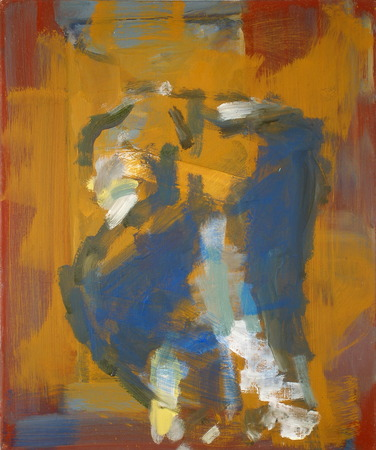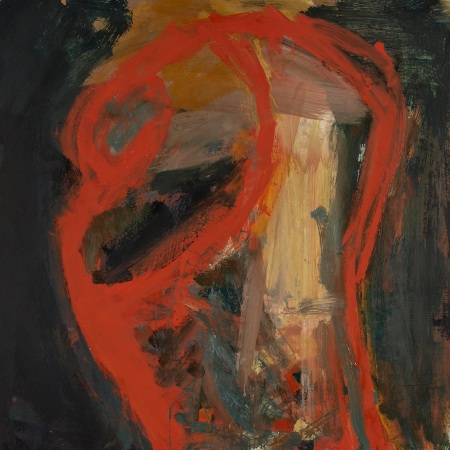Holding Pattern
Natasha Prévost
There are two main ways to reflect upon Lex Braes' "Holding Pattern" series.
The first: Looking at "Holding Pattern" as circumvention around the same model. Repetition of the same. This one is obvious.
The second: Leaving aside the literal definition that comes to mind and concentrating instead on the movement. In this way, the observer notes a change of form. The figure looks at times tough, crude, frail, dominant, desperate, revealing, self-protecting, dancing even crying out. In his everyday affective transformations, the painter holds onto the pattern while slightly or radically modifying brush movement, color palette, the light or the darkness investing the figure, his clarifying or blurring of the form's contour. "The line between art and life should be kept as fluid, and perhaps indistinct, as possible," said Allan Kaprow." A philosophical influence is empirically experienced by the painter.
"I'm having a long painful studio day with little glimpses of light -- I'm so unsure -- imprisoned in myself and then I glimpse some light… the dark part for me is that it isn't evident, you know that this so called "art" I am involved in isn't actually provable, it is utterly subjective and that leaves it fragile and in need of protection… I suppose that is where the handlers and the shakers and makers take control of the conceit and give it a believable body to be negotiated with the viewers" (Lex Braes Studio diary, September 8th, 2009).
Each painting is an emotional instantané where at times we witness the realm of emotions and sensations speaking louder (abstraction) while at other times when the painter is in control, he fixes the archetype of a man on the canvas (figuration) each being capsule's of pure intensity.
"I regard instants of time as real things, identifying them with possible instantaneous arrangements of all the things in the universe. They are configurations of the universe. In themselves these configurations are perfectly static and timeless. But how and why can something static and timeless be experienced as intensely dynamic and temporal?" (The End of Time. The next revolution in our understanding of the universe by Julian Barbour, 1999).
But how and why can something static and timeless like a painting be experienced by an intensely dynamic and temporal painter? Life avatars face adversity and undergo transformations, both being the basis for individual evolution. The first painting of what was to become a series of seven (both large and medium scaled) was created in the context of his understanding of his life. Between completing the first and the last painting of the series, the painter changed; from insecurity to reaching quasi-complete assurance. Yet, the dynamic and temporality of this location will certainly engender future metamorphosis and thus, new life and creative projects for the painter. By now, it is the visual art spectator who finds herself in a holding pattern.
Natasha Prévost, Grand Barachois, NB Canada, 2009





